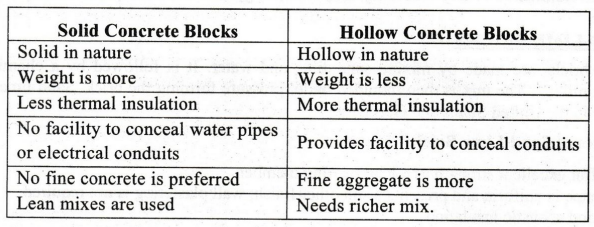Basic Civil & Mechanical Engineering: UNIT II: q. Modern materials
Alternative building blocks
Civil Engineering Materials
1. Fly ash bricks, 2. Sand lime bricks, 3. 3. Autoclaved aerated concrete (aac) , 4. Concrete blocks ,
ALTERNATIVE BUILDING BLOCKS
1. FLY ASH BRICKS
Pulverised
ash brick (PAB) technology is a process of converting industrial waste
materials into quality building materials. At present, the technology is well
established in converting thermal power plant waste into quality bricks.
P
AB technology uses fly ash, filler materials (usually coarse sand or stone
crusher dust) and additives (lime, gypsum or cement). The strength of the
bricks can be engineered by varying the compositions. Equipment used can be
manual or mechanised. Mechanised machines deploy hydraulic compaction to
produce a variety of bricks and can be operated through electric or diesel
power.
Fly
Ash
Pulverised
coal ash (PCA) is one of the major residues generated during the combustion of
coal in thermal power plants. Though PCA is a waste product for the power
sector, it is used as a raw material, primarily, in construction. PCA is
generally classified into three types depending upon its particle size and zone
of collection.
Fly
Ash’is
the extremely fine ash ‘flying' along with flue gases that is trapped in
electro-static precipitators (ESP) and collected. The relatively coarser ash
generated at the bottom of the boilers is mixed with water, made into slurry and
pumped into fill sites called “ash ponds'. This ash forms the bulk of the ash
generated and is termed as 'Pond Ash'. Depending upon the boiler design and
efficiency, the ratio of fly ash to pond ash varies between 70:30 and 80:20.
In
some older and relatively inefficient thermal power plants, a coarser variety
of ash is generated called 'bottom ash'. This has appreciable carbon content
but cannot be collected separately. This is also mixed with pond ash and pumped
to ash fill sites.
Advantages
of Fly Ash Bricks
1.
High compressive strength
2.
High strength to weight ratio
3.
Lower water absorption
4.
Uniform in shape and size; require less mortar in brick work.
5.
Environment friendly - uses fly ash, less energy intensive compared to clay
bricks
2. SAND LIME BRICKS
Sand
lime bricks are made by mixing sand, lime and water. It is followed by a
chemical process during wet mixing. The mix is then moulded under pressure
forming the brick. Sand lime bricks find greater use in the United States and
Germany.
Advantages
of Sand Lime Bricks
1.
Offer excellent strength as a load-bearing member
2.
Shape is uniform and presents a smoother finish; wall plastering is not
required
3.
Good acoustic insulation
4.
Good heat and humidity accumulation
5.
Excellent fire resistance
6.
Have gray color and possess pleasing appearance
7.
Better noise absorbing qualities
3. AUTOCLAVED AERATED CONCRETE (AAC)
AAC
is produced by mixing quicklime with cement, sand, water, gypsum and aluminium
powder. It results in slurry that rises and sets to form lightweight honeycomb
structured blocks. Quicklime, also known as calcium oxide (Cao), is a caustic
alkaline substance. Quicklime has been used by humans for centuries for many
things such as mortar, flux, in mixtures to waterproof boats and for
whitewashing houses.
Advantages
of AAC
1.
It is a lightweight, precast, concrete building material.
2.
It provides thermal insulation, fire-resistance and mold-resistance for a
masonry structure used for housing and industrial buildings.
3.
It is recognized as a sustainable building technique
4.
It is very resource efficient, as densities can be achieved in the range of 250
kg/m' for brick materials.
Uses:
Quicklime, which offers dedicated reactivity and fineness, is one of the key elements
in the process to cast AAC products. These include blocks, wall panels, floor
panels, roof panels, cladding (facade) panels and lintels.
4. CONCRETE BLOCKS
Solid
and hollow concrete blocks are manufactured to meet the requirements of
building blocks in towns and cities. These blocks may be termed as artificial
stones, since they replace stones in masonry construction. They are
manufactured with lean mixes of cement, sand and aggregates of size less than
12 mm. Round aggregates are preferred over sharp-edged aggregates. Solid
concrete blocks of size 400 mm × 200 mm × 150 mm are commonly manufactured.
They also come in a wide variety of shapes and sizes. A comparison of solid and
hollow concrete blocks is given in Table 1.
TABLE
1 COMPARISON OF SOLID AND HOLLOW CONCRETE BLOCKS

The
advantage of using concrete blocks is that the construction activity is fast.
Mortar requirement for finishing the surface is less and plastering is not
necessary. Both solid and hollow blocks can be used for the construction of
load bearing as well as partition walls. They are ideally suited for the
construction of compound walls. Solid blocks are used for paving where holes
would be dangerous or inconvenient.
Basic Civil & Mechanical Engineering: UNIT II: q. Modern materials : Tag: : Civil Engineering Materials - Alternative building blocks
Related Topics
Related Subjects
Basic Civil and Mechanical Engineering
BE3255 2nd Semester 2021 Regulation | 2nd Semester EEE Dept 2021 Regulation
